|
The sky is clear this week, but I can't go out every night - with two kids, I just don't have the stamina - so I figured I'd write some reflections on the astronomical accessories that have made an impression over the years, good or bad. Because I have to walk to my observing sites and because, as a father with a demanding job, I don't usually have much time to observe, the equipment that works best for me might not work as well for everyone - and the same applies for the stuff I didn't like. Still: some thoughts. The good stuffOrion 6x30 right-angle finder I've used countless finders over the years. There were red dot finders from Baader, Celestron, and Riger; there were finder scopes from Celestron, Skywatcher, Explore Scientific, Orion, and Takahashi. Of all the finders that have graced my telescopes, this is by far the best. It's lightweight. It's easy to mount. It doesn't hurt my neck. The field of view is just the right width. The optical quality is good enough to get the job done. And most importantly, I can always align it within moments. The adjustment screws are a snap to use, and so well placed. I'll admit: I don't love the dew caps - they can be a little dicey to remove - but everything else is just about perfect. Any Berlebach tripod If you need a tripod for your telescope, these are the ones to get. They're made of beautiful wood that simply does not get scuffs or scratches, so it always looks new. The build quality is incredible. They're a little heavier than some metal equivalents - especially if the metal is carbon fiber - but they absorb vibrations very well, and are therefore more stable than other tripods. What's not to like? TeleVue Delos eyepieces I've used just about every kind of TeleVue eyepiece over the years, from relatively inexpensive Plossls (see below) to the flagship Ethos brand. To my mind, the Delos eyepieces are the best of the lot. The eye relief is great, the contrast impeccable, and the field of view is wide and flat. The difference in contrast between the also-excellent Nagler eyepieces and the Delos line is subtle but definitely noticeable on, for example, Jupiter and Mars. The only downside is that the Delos eyepieces are heavy, and therefore not exactly transportable. TeleVue Nagler 3-6mm zoom eyepiece This is my favorite Nagler eyepiece. The contrast is nearly as good as I get with the Delos eyepieces, yet it's much lighter and it toggles effortlessly between magnifications. I make sure to always have it around when the seeing promises to be good, and I can crank up the magnification on the refractors. TeleVue Plössl eyepieces They're not super pricey, but oh so much better than anything you can buy from a lesser manufacturer. Their contrast rivals that of the Delos eyepieces, but the field of view is narrower, and there's definite field curvature at edge of view. If your target is relatively small and you can keep it centered, these eyepieces offer incredible value. TeleVue Everbrite diagonals I really love these things, in both the 1.25" and 2" models. They're made from a solid hunk of metal, and they always seem to give me cool, bright views. Their clamping screws are oversized and a breeze to use in any weather. Baader 2” BBHS Sitall Mirror Diagonal As good as the Everbrite diagonals may be, the premium competition from Baader is generally regarded as just a touch better. I have to confess that I've never noticed a clear difference optically, and that I prefer the mechanical quality of the TeleVue diagonals. Yet the clicklock feature of the Baader variants is just such an improvement over anything else out there. The last thing you want to do in the darkness is mess with screws; Baader removes that necessity. For a sky-high price, of course. DiscMounts DM-6 This is a huge hunk of metal: like a miniature Borg cube, and no less threatening when you face the prospect of hauling it to a park in a backpack. I like my mounts to weigh substantially less than my telescopes - ideally less than half as much - whereas the weight of the DM-6 approaches that of my largest telescope. And yet: it's a beautifully crafted manual mount. You can just feel the attention to detail that has gone into its design and construction. Tracking the planets at around 200x is so easy and smooth with this mount, and it's a snap to adjust its tension to make it smoother still. So it's painful to transport, but a joy when set up. DiscMounts DM-4 It's much smaller than the DM-6, but made with equal care and precision. Once again, the mount-weight to telescope-weight ratio isn't ideal. This mount barely handles my Takahashi FC-100DZ. Yet it slips easily into a backpack or suitcase. Easier to transport, and a bit less joyful to use. ORCA OR-732 Hexagon Soft Tripod/Light Stand Bag Since I have to walk a ways to get to my observing spots, I really care about lightweight carrying cases. For my mid-sized tripods, this is the best I've found. It's very well made, comfortable to carry, heavily padded, and (somehow) quite light. Oh, and it's durable, which can't be said about every carrying case. Pacific Design Soft Case These carrying cases are incredible for catadioptric telescopes, especially a C8. They fit snugly, are extremely lightweight, and are just perfect to carry. They make an already portable telescope that much easier to transport . . . though I confess that they don't seem to have a whole lot of padding. Mixed feelingsAYO II and VAMO Traveler mounts This is a tough one. Both mounts are beautifully made and, unlike their DiscMounts competition, remarkably lightweight compared to the telescopes they can carry. At just three pounds, the Traveler held my C8 with no problems, though the FC-100DC was a little shaky on a breezy night. At around six pounds, the AYO II carried my APM 140 - not easily, but well enough to allow high-power planetary observation. On paper, that should make these mounts hard to beat. Yet the Traveler arrived with a malfunction - I could never adjust a knob to control the tension of its horizontal axis - and, after just a year, the AYO II developed unacceptable slippage in its vertical movements. At that point, it was essentially useless to me. Add to that the paint chips that started chipping off the mount, and my initially extremely favorable impressions quickly soured. These mounts are really expensive, and deploy really simple technology. They should last longer than a year. Explore Scientific Twilight mounts I bought this mount and tripod combination twice. Both times, I really enjoyed its relatively light weight, and its slow-motion knobs. Both times, magnets holding an Allen key to the mount - which you can use to adjust the angle head - simply fell off. The slow-motion knobs did, too. One mount I bought didn't allow me to adjust the angle head at all; the other did. Explore Scientific, in my experience, has quality control problems. Explore Scientific 82° eyepieces These were my bridge from the realm of cheap eyepieces to the hallowed ground of TeleVue. Yes, they were clearly superior to the Celestron Plössl eyepieces that ship with telescopes. Yet I didn't find the view as crisp and clear as those I get with my Delos eyepieces, for example. They're also less than half the cost of those eyepieces, so you do get what you pay for. Neewer 44 inches Rolling Camera Case This gigantic rolling case is almost great. It used to hold my APM 140, AYO II mount, eyepieces, finder, and stool. Now it holds my Berlebach Uni tripod instead of my TEC 140, which I carry. It's almost great because its handle is way too short, which means it's awkward and heavy to transport for more than a few minutes, and it doesn't seem to have any shock absorption, despite Neewer's promise of an "anti-shock padded compartment." I would gladly buy this case again - I couldn't imagine hauling a big refractor to a park without it - I just wish it was a little more optimized for my needs. Universal Astronomics MacroStar Deluxe I've owned two Universal Astronomics mounts, and this was the best by far. It was surprisingly lightweight for a mount that can hold a 10" Schmidt–Cassegrain, and it seemed really solidly made. Yet it had a little too much resistance - movements were not perfectly smooth, even with my 8" Edge HD - and there was something a little rough about its build quality. The optional eyepiece tray that I got with it also had razor-sharp edges that threatened to decapitate me in the darkness, which is usually not ideal. Skywatcher AZ GTI It's lightweight! Yet it requires eight (!) AA batteries - no rechargeable lithium here - and it's noisy as it slews to its targets. Instructions are totally inadequate, and the software seems years out of date. Plastic parts galore reflect mediocre build quality. Lots of people like this mount; spoiled by premium manual mounts, I did not. DisappointingCelestron Eyepiece and Filter Kit I imagine a lot of people buy this kit when first getting started, and I was no exception. I wanted more magnification from my telescope - surprise, surprise - and I convinced myself that filters would help me see planetary detail. Trouble is: most of these simple Plössl eyepieces have such small focal lengths and terrible eye relief that they're almost impossible to look through. Otherwise the quality of the eyepieces is mediocre at best, and the quality of the filters is even worse. As soon as you realize that quality eyepieces exist, you want nothing to do with these. And then you're out about $150, because this thing is not easy to sell for much on the used market. Seasoned observers know exactly what it is: a trap for the inexperienced. Takahashi 6x30 finderscope and bracket This is blasphemy, I know. The Takahashi 6x30 finders are generally regarded as among the best - perhaps the best - on the market. And yes, the optical quality is superb. But it's so easy to scratch the paint job using the bracket, which is a pain to adjust and must be unscrewed to remove from the optical tube assembly. Straight-through finders also hurt my neck. But more importantly: do you really need to pay a premium for a finder that has optical quality to match your fine refractor? In my experience, the answer is no. Takahashi Extender-Q 1.6X As I chronicle in these pages, I once had an FC-100DC. By reading entirely too many forum posts and reviews - on CloudyNights, for example - and by observing during a stretch of mediocre seeing, I came to the conclusion that I could meaningfully improve its planetary performance by buying this little gadget . . . for a cool $600. When it arrived, I found a way to screw it in despite typically terrible Takahashi instructions. For a while I convinced myself that it really did improve my views of Jupiter or Mars, except it lengthened my telescope, altered its center of gravity, and generally made it excessively wobbly on a light mount and tripod. I struggled with that as best I could, until one day it dawned on me - partly by reading this journal - that I really couldn't see noticeably more than I could without the extender. So I sold it. The biggest issue in the end was that the telescope already worked perfectly well without the extender. Sometimes the urge to see just a little bit more is a fool's errand. Universal Astronomics Medium Tripod More blasphemy! Universal Astronomics used to make some of the best manual mounts around. But this tripod was all creaky, heavy aluminum that quickly developed signs of wear and tear. It wasn't all bad - it was stable and the built-in carrying strap was great - but give me wooden tripods, please. Vixen Optics Star Guy Telescope Case SGC10 This is an exceptionally well-made carrying case for a catadioptric telescope. It is also comically heavy. If all you want to do is move your telescope a few steps from the garage to the backyard, fine. If you want to actually carry a Mewlon 180, for example, for more than a few steps . . . well, you might as well transport a C11. It's that heavy. More concluding thoughts. In this hobby, I've consistently lost money by buying something that was good but not great; deciding I really did need or want something great; and then selling that good item at a loss to finance the great item I should have bought in the first place. Perhaps that's just my personality, though this hobby can lend itself to perpetual discontentedness with the equipment you already have. There always seems to be something a little better around the corner.
To that end, I've also lost money by buying what I thought I might be able to use someday, rather than what I knew I could use right now. That has always, always been a mistake, and I'm trying hard to avoid making it again. Maybe this time I've finally learned my lesson.
0 Comments
It was another beautifully clear, autumnal night on the evening of the 26th, so out I stepped with my FC-100DZ, bound for a nearby field. This time I carried a new, lightweight tracking mount: the Skywatcher AZ-GTi. Several observers have enjoyed using the mount with their Takahashi refractors, and for me the prospect of a small, straightforward tracking mount was hard to turn down. If I can the planets in my sights for longer, I figured, I could have a chance of more seriously observing them - and more easily showing them to my students, friends, and family. I have to say, years of using fine refractors and simply but well-crafted mounts and tripods have given me expensive taste. When the Skywatcher arrived, I was a little put off by the cheap build quality: the plastic, the AA batteries, the (in some places) poorly thought out design. The instructions were completely inadequate, and the software seemed really dated. In the field, I could not get the thing aligned right away - better instructions would have solved that - and I was put off by a motor that had to have been two or three times loader than the one inside my EVScope. In the end, I managed to align things well enough that the planets stayed in my sights for meaningfully longer than I would with a manual mount. Seeing was mediocre at best - I could just make out the Great Red Spot, but I couldn't see much of the Cassini Division - so I didn't last long. I'm still not sure whether to keep the mount, but on the grueling walk back I did get to thinking about the equipment I've especially enjoyed in this hobby, and why I enjoyed it. I often find that reviews I see online miss a lot; they focus on trivial optical differences between telescopes, for example, without adequately considering far more substantial mechanical distinctions. I've ranked equipment before in these pages, but on my walk I thought it might be fun to try it again. Below, I rank all 20 (!) telescopes I've used in tiers, according to my own experiences and preferences. That means I'm not comparing them to each other in a vacuum; rather, I'm evaluating how they worked for me. In a subsequent post, I may reflect on some accessories that have stood out to me, good or bad, and some brands I particularly enjoy or dislike. Anyway, here goes. Essentially flawless1. Telescope Engineering Company (TEC) 140 This is a perfect telescope. For a triplet (meaning it has three lenses) it's extremely lightweight, and because it's oil-spaced it acclimates very quickly. Its mechanical quality has no peer; from tube rings to focuser to sliding dew shield, everything looks beautiful and works perfectly. And the optical quality is about as good as it gets. On a good night, the view is truly stunning; you feel as though you're actually in a spaceship, approaching the objects you observe. The one drawback? This thing will cost you about three times more than an APM 140, which can give you at least 90% of the performance. Excellent, with some caveats2. Takahashi FC-100DZ Not much to complain about here, either. The TEC 140 provides views that are virtually free of chromatic aberration (false color) by using a third lens; the DZ achieves a similar feat despite being a doublet because its two lenses are made of crystal (fluorite) and exotic, low-dispersion glass. Since it's a doublet, it cools down in no time and weighs very little. Like all Takahashi telescopes, it has a very distinct, airy and beautiful style in teal and "Corvette white." The mechanical quality is exceptionally high, and in fact I debated whether to place it in the same category as the TEC. Yet for the FC-100DZ, excellence comes with minor caveats. The telescope's sliding dew shield can wobble ever so slightly when it's fully extended and you're trying to pull off the dust cap. There's a screw on the dew shield - which the TEC lacks - that when fully screwed in (to lock the shield in place) eventually leaves a small mark on the paint of the optical tube. The focuser works well but is a bit too sticky for fine adjustment at high power in particular; in my view you really do need to buy a two-speed focuser upgrade (I prefer Takahashi's MEF-3). Even then the focuser doesn't have that buttery-smooth feel of the Feathertouch focuser that comes standard on the TEC, for example. Takahashi's vixen-style dovetail is far too long and heavy for such a small telescope; substitutes by ADM Accessories work better. Everyone praises Takahashi's finderscopes - their optical quality is truly special - but straight-through finders like those made by Takahashi are hard on the neck, and I really don't like Takahashi's mounting bracket. Getting everything to just work effortlessly with Takahashi telescopes always takes some adjustment, and often extra expense. In my experience, it can be a weeks-long process. Still, once you've figured everything out, on a good night, it's hard to believe that such a little telescope can show so much. It's a stunning instrument. 3. APM 140 I had my APM for just under a year. To me, that's hard to imagine for two reasons: first, that year began roughly with the onset of the COVID-19 pandemic, and oh what a long twelve months it was; second, I had so many memorable experiences with the APM that it felt like I'd owned it for a decade. These pages chronicle some of the wondrous things I saw: six stars in Orion's Trapezium; intricate, linear features stretching around Mars; Jupiter's belts and zones in glorious detail; the nucleus and tail of comet NEOWISE plunging towards the horizon; and rilles - countless rilles - winding across the Moon. Of all the telescopes I've owned, only the TEC 140 has given me better views than the APM. The APM is a doublet, however, which means it's noticeably lighter and a bit more compact than the TEC. Its build quality is not quite at the level of the TEC, but still really impressive. The two-speed focuser is great, and so are the sliding dew shield and tube rings. The cost is also very reasonable for such an excellent mid-sized refractor (which means it's high, but not obscene). The only drawback is that its relatively fast focal ratio gives it just a hint more false color than the TEC or FC-100DZ, which makes it just ever so slightly worse for planetary viewing. Still, I can't recommend this telescope enough. 4. Takahashi FC-100DC The FC-100DC is a lot like the DZ - a truly spectacular little telescope - except it shows just a bit more false color, has a slightly faster focal ratio, and only accommodates 1.25" diagonals and eyepieces. As far as I can tell, the optical difference is only noticeable on nights of good to excellent seeing. If you love observing subtle detail on Mars or hate even a hint of false color around the lunar limb, perhaps that matters a little. What's much more noticeable, however, is the DC's lighter weight, which means that it can be mounted on a much flimsier mount. Having sold the DC for the DZ, I miss that portability. Yet even more important than that: the DC's visual back relies on a series of screwed-in "couplings." In order to achieve focus, you have to screw or unscrew a number of these little tubes. It is, in my experience, very easy to screw these tubes in too tight, especially if you're attaching and detaching your diagonal or eyepieces. When that happens, they become impossible to unscrew without damaging them, even with tools. It is then also impossible to change the configuration of the telescope or even exchange diagonals. Ultimately I did damage the couplings of my DC, and that did affect its resale value when I decided to get the DZ. The DZ has a different, more conventional system, and it makes a very big difference. For that reason, I would always buy a DZ over the DC, in spite of the increased cost and the slight but meaningful weight difference. 5. TeleVue 85 I've sung the praises of this telescope in entry after entry in this journal. It truly is a little powerhouse. Only the TEC has better build quality - though it really is very close between them, I prefer the TEC's sleek paint job and more robust focuser - and the sharpness of the view through the TV 85 is truly remarkable. In fact, this telescope is why I switched over to refractors. I'd never clearly seen the Great Red Spot before using my Edge HD 800; when I did after using the TV 85 for the first time, I knew there was no going back. However, the TV 85 has some real drawbacks. For one, it's heavy for its size - about as heavy as the FC-100DC - and its fast focal ratio makes it less well suited for planetary observation than some other fine refractors listed here. It doesn't have a lot of false color - not at all - but it has noticeably more than the FC-100DZ, for example, and that means that Mars in particular is not an ideal target for the TV 85 (though the telescope is peerless for open clusters). Lastly, the price is a little ridiculous. I can't fathom why this telescope costs nearly as much as a Vixen ED115S, for example, which is a much more capable instrument, or three times more than the very comparable Zenithstar 81, or about the same amount as the FC-100DC. The resale value of these telescope relative to its new price is lower than that of just about every telescope on this list - so if you want one, be sure you really want it, and buy it used. 6. William Optics Zenithstar 81 I'm not sure where to place this telescope. It's incredibly lightweight and compact, which is what you want in a small refractor. Its build quality seems exceptionally high - it's beautiful to look at, and I think the William Optics tube rings and dovetail combination might be the best there is - while the optics are sharp and virtually color-free. To be honest, I really don't understand how this telescope costs so much less than either the TV 85, which provides only marginally superior views, or the FS-60Q, which is a more specialized and in some respects less capable telescope. And the Zenithstar comes with a heap of genuinely well-made, useful accessories. Is there something I'm missing? I'd be tempted to place the Zenithstar in fifth place, but I think the TV 85 is probably a bit better at high magnifications. 7. Unistellar EVScope Again, I'm not sure where to place this digital telescope, which is of course in a different class than every other instrument on this list. I can set it up and align its go-to software within seconds. Thereafter it slews effortlessly from one deep space object after another that I could never even glimpse - let alone observe - with even the TEC 140. Imagine being able to admire white dwarfs, and nebulae in other galaxies, from the light-polluted heart of a major city, using a telescope that you can slip easily into a large backpack. I never would have thought that was possible. So why isn't it higher in these rankings? For one, seeing the cosmos through a screen - even if that screen is at the bottom of an eyepiece - is just not the same as seeing it through fine glass. There is a level of separation you feel when looking at a screen that you just don't get while peering through the transparent glass of a fine refractor, which can feel like an extension of the eye. Second, the resolution of the sensor, the relatively constrained field of view, and the inadequacy of the eyepiece - which gives you the sense that you're looking down a well at a distant television - all detract from the experience. I probably reach for this telescope more than any other - it's just so convenient, and there's so much to see in deep space - but I can't place it any higher on this list. Maybe I'll feel differently about its successor, the EVScope 2, which debuts in just two months. 8. FS-60Q Technically, the TV 85 gathers almost twice as much light as this little telescope. Yet line up both instruments to observe the Moon at low or medium power, and the first thing that stands out is the perfectly color-free views in the FS-60Q. In these pages I compared pictures of the Moon that I took with the FS-60Q to those I took using the APM 140, and I could almost not tell the difference. The view of Mars at opposition was similarly baffling. You'd think that the 60Q would be in a different class than the much bigger telescopes, but for low- or medium-power lunar and planetary observing that was not always the case. To top it off, the Takahashi build quality is (predictably) excellent, and you can actually unscrew the optical tube so the separate halves fit in a mid-sized backpack. Imagine that! And yet . . . with tube rings (or clamshell) and the smallest, non-Takahashi dovetail you can buy, the fully assembled FS-60Q is scarcely lighter or smaller than the TV-85. Just look: This means that, relative to the TV-85 or Zenithstar, the 60Q technically gathers far less light in exchange for a slight reduction in false color. At high powers, or for observing deep space objects, that inferior light gathering starts to become really significant, easily overwhelming the advantage of perfectly color-free views. And yes, it's really cool that you can split the telescope into two halves. In fact, one of those halves is a perfectly functional telescope - albeit with much more false color than the fully assembled unit - so when you buy the 60Q, you're really getting two telescopes in one. Screwing both halves together in the dark can be loud, frustrating, and at times harrowing, however, so in practice I actually preferred setting out with the 60Q fully assembled. Before long I didn't even do that; the small telescopes ranked above it were simply better. The Zenithstar in particular gathers much more light, is much more portable, and is much easier to use (partly because it's compatible with most accessories in our hobby, while Takahashi telescopes aren't). 9. Vixen ED115S I truly loved this telescope. It didn't gather much more light than the four-inch (100mm) refractors on this list, and it was noticeably longer and bulkier. Yet out in the field, it really was a joy to use with my AYO II mount. It was perfectly stable, wonderfully balanced, and the optics really gave up very little if anything to those of the FC-100DC, for example. Perhaps the view of the Moon or Jupiter was a bit warmer than what I got with the other refractors in this category, but it was hard to say. So why is the Vixen ranked so low? I got mine with an upgraded, MoonLite focuser, and a beautiful William Optics tube ring and dovetail combination, all in a deep red. The observer I sold it to was delighted, I assure you. Yet the ED115S normally sells with mediocre (at best) tube rings and an undersized focuser that do not at all befit a telescope of this quality and price. For that reason, I might avoid buying one new. More importantly, 4.5" refractors with relatively long focal lengths (this is an F 7.7) have a problem. They gather only a little more light than 4" refractors, yet they require a more stable and therefore heavier mount and tripod. In fact, the setup that was stable for my ED115S was just about as steady with my APM 140, even though that telescope gathered far more light and showed much more. A harsh but not entirely inaccurate conclusion would be that the 4.5" refractor combines the shortcomings of both small and medium-sized refractors, with none of the benefits. 10. Takahashi Mewlon 180 I didn't own this telescope for very long, and I can completely understand why others might rank it higher. It's beautifully made; I compared it to a streamlined jet engine in these pages and it really does look like one. Very few telescope manufacturers design instruments with the style and grace of Takahashi telescopes. The only problem is that the Mewlon takes a long time to acclimate - longer than I had - and it seemed like it would be a chore to collimate. To me that made it less enjoyable to use than a fine refractor, but others in different circumstances might feel differently. A clear step down, but still good11. Celestron C8 The plain old orange-tube C8 I bought new several years ago fit comfortably on my lightest mount and tripod: a combination that had difficulty accommodating my FC-100DC. That says it all, doesn't it? You will not find a more portable, do-everything telescope than a C8. When properly collimated and acclimated, it can provide truly impressive views of - in my experience - the planets in particular. Acclimation takes a while, however, dew is a persistent problem, there's field curvature at the edge of the view, and the build quality is thoroughly mediocre. Add to that the variation in between samples - some C8's are great, others less so - and this is a clear step down from the telescopes above. But what value for the price! 12. Skywatcher 100ED My view of this telescope has soured slightly from when I last ranked instruments on this site. On a night of mediocre seeing you could position this telescope next to a Takahashi of similar aperture and, at low or medium magnifications, not notice a difference on most objects. Considering that the telescope sold at less than $650 during regular sales when I last did this ranking, that prompted me to view it as maybe the best bargain in the hobby. Now it's much more expensive, however, and I'd no longer call it much of a steal (except on the used market). Because it doesn't use exotic glass, its focal ratio is slow to reduce false color, and that makes it heavier and much more unwieldy for its aperture than the other telescopes on this list. You will need a mid-sized mount. Yet it still does not focus all wavelengths of light perfectly at focus to produce crisp views of, for example, Mars or Jupiter. It's telling that I could never clearly make out the Great Red Spot using this telescope, but I instantly could with the TV 85 (which shows a bit more false color than some other refractors on this list). The build quality of the telescope is mediocre, though meaningfully better than that of many telescopes lower on this list. So again, a step down. And yet: I had a beautifully clear view of the Orion Nebula with this telescope one winter night that almost drove me to tears. I'll never forget it. 13. Celestron C6 It's everything I said about the C8, except it doesn't pack as much punch. It's not much easier to mount or transport than the C8, and it has all the drawbacks of the bigger telescope. So why not opt for the extra aperture? In most - though not all - cases, that would be the right move. 14. Celestron C90 I wasn't sure where to place the C90. Put it this way: I've had better views of Jupiter using my C90 than I've had using any but the top nine optical telescopes on this list. Yet the C90 fits into a small backpack and costs less than a half-decent eyepiece. There's a case to be made for placing it at the top of this category, but it's a Maksutov Cassegrain and therefore it takes longer to acclimate than you might think. Build quality is so-so, but far higher than you'd expect at this price. The field of view is a bit narrow, given the aperture, but a C90 is hard to beat for a first telescope, or as a travel scope. Good for the money15. Skywatcher 127mm Mak Maksutov telescopes are like Malthusian traps: the downsides of using them increase geometrically as their aperture increases arithmetically. That means that while a C90 is a fun little thing that affords a full view of the Orion Nebula and cools down in a half-hour or so on a brisk autumn night, the larger 127mm from Skywatcher takes annoyingly long to acclimate and provides a much more constrained field of view. On one winter's night, my 127mm was still cooling after an hour. On the other hand, the telescope doesn't need collimating and it's very easy to transport, so it makes for a capable, easy-to-use travel telescope. Mechanical and optical quality are typical Skywatcher: good enough, but not great. 16. 4" Celestron Omni XLT refractor I don't think they make this little thing anymore, which is a damned shame because it performed exceptionally well for the price. It looked like a toy and the build quality was laughably bad, especially for the supplied diagonal. Yet the optics were impressive (again, for the price): at least on par with those of the AR 102, for example (below). For a couple hundred bucks, you used to get a portable wooden tripod, simple mount, and telescope that could show you cloud belts on Jupiter and a hint of the Cassini Division in Saturn's ranks. I guess that wasn't profitable for Celestron? Disappointing, to me17. Celestron Starhopper I've already reviewed these next four telescopes, so I'll only offer a few extra thoughts. The Starhopper is an older dobsonian - the first real telescope I used, in fact - and it's badly outclassed by today's competition. I remember that the mount in particular was flimsy plywood, the optical tube was little more than thick cardboard, and the focuser was cheap plastic that cracked when I knocked it into the wall. Yet optical quality was good enough, and that's about what you could hope for 20+ years ago. 18. Celestron Edge HD 800 My experience with the C8 leads me to believe I acquired a very bad sample of an Edge HD. Some people swear by the design. At first - in mediocre seeing - I rather liked it! But I reluctantly began to change my mind when atmospheric conditions improved and the views I was getting didn't. Eventually, comparing it to a fine refractor - the TV 85 - led me to leave catadioptric telescopes behind for good. I'll never forget the disappointment in the voices of neighbors who viewed the Moon through this telescope after it was fully acclimated and collimated. 19. Explore Scientific AR 102 In a subsequent post, I may reflect a little on the equipment I've acquired from Explore Scientific. The price always seems unbeatable, until things start falling apart. That's always a risk with non-premium astronomical equipment, but it's greater with some brands than others. Let me tell you: it's not fun when you're doing outreach and a young person eager to see the Moon up close for the first time has to actually cradle your telescope's focuser in place - in its optical tube - because it can't handle a mid-sized eyepiece. 20. Skywatcher Flextube 12" Dobsonian This was too much telescope for me, and the variant I bought - used, about 12 years ago now - was of low mechanical quality and took far too long to acclimate. The only thing I remember seeing clearly with it was a boiling blob that I knew (intellectually, but not by looking at it) was Mars. A few parting reflections. First, in my now-extensive experience, the most meaningful improvements in telescope performance all take place under the $1000 threshold. There can be a massive jump in the performance of a $900 telescope, for example, versus a $500 instrument. Yet the difference between a $900 telescope and something that's double or triple the cost can be quite subtle.
In my view, the telescopes on this list that provide the best value for the money are the APM 140, the William Optics Zenithstar 81, the Celestron C8, and the Celestron C90. Were I were buying a first telescope out of that group, I would without hesitation choose the Zenithstar . . . if I had the money for it. I've sold and exchanged most of these telescopes over the years to acquire instruments that are ideally suited for my work and pleasure. I have a small group left over. If I had to keep just one, I wouldn't have to think long about it: it would be the Takahashi FC-100DZ. But I have to walk to my observing locations. If I had a backyard, I would immediately select the TEC 140. If all I could take was the APM 140, however . . . I could cope with that just fine. We've had some wonderfully clear, autumnal nights over the past week, with Jupiter and Saturn riding high in the evening sky and the Moon waxing and waning nearby. I'm teaching what may be my favorite course at the moment - about the human history of nearby celestial bodies (what I call "neighboring worlds"), and a special highlight is taking my students out for a night with a telescope. I have now accumulated some very fine refractors, however, and I worried about how they'd fare after being handled by twenty students. To that end, I drew on my research funds to buy a William Optics Zenithstar 81. It's a beautiful little refractor, and I figured that it would be more than adequate to give my students an impressive view of the Moon. For their first assignment, they need to find a feature on the Moon and then write a history of how people have understood, imagined, explored, or planned to exploit that feature. A few things immediately struck me about the Zenithstar. First, it costs about a third as much as the TeleVue 85 I used to own - less than a third, when you consider it comes with its own mounting rings, dovetail, Bahtinov mask, and carrying case - despite giving up only four millimeters in aperture. Second, its build quality looks to be on par with the very best telescopes I own and have owned, with the possible exception of my TEC 140. Third, it seems to weigh less than the FS-60Q I once owned, and much less than the TV 85, and its sliding dew shield makes it much more compact than either telescope. It was really easy to carry the telescope to a darker corner of campus, and there set it up on my DM-4 mount and Berlebach Report tripod. Almost immediately, the Plossl eyepieces I'd decided to use provided beautifully crisp views of the nearly fully illuminated Moon. The students who had started to gather were predictably impressed. When we found we had a few minutes to spare at the end of the evening, I decided to try showing them Jupiter and Saturn. At about 56x, the planets were small, but beautifully sharp and clear. Many of my students were awestruck; they had a hard time believing that they could really see the major cloud belts of Jupiter and the rings of Saturn from downtown DC. Experiential learning is always special; it makes the otherwise abstract concepts we discuss in class come alive for my students, and it can provide lifelong memories. I for one was stunned by the performance of the little refractor. It is, by far, the most portable telescope I've owned, and when it comes to performance it really doesn't give up much to the TV 85. I loved my TV 85, but I would have a hard time recommending that telescope as a go-to instrument when the Zenithstar seems to provide so much more value for the cost. Last night conditions were even better, and now I resolved to head out with my biggest telescope: the TEC 140. The weight of the telescope, tripod, and mount means that I really can't haul everything to my favorite field. I targeted the little alcove next to a church that I've used over the past year, yet when I arrived as I was dismayed to find that the church had installed a new streetlight that completely ruled out observing there. I wandered about, dragging my heavy gear, until I decided to head down to a little amphitheater near the National Cathedral. There I found a perch that, if I moved around a bit, afforded me a view of Jupiter, Saturn, and the Moon through the canopies of nearby trees. When I swung the TEC to Saturn, I was mesmerized. This was only the second time I'd used the TEC, and the first time in good seeing. In those conditions, Saturn looked absolutely stunning, like a beautiful jewel set in a velvet background. Its many moons were brilliant and sharp, and the shadow of the planet on its rings gave me the rare sense that I was actually seeing a world in three dimensions (often, objects in the eyepiece look flat, and therefore two dimensional). Cloud details were obvious on the planet's yellow-white disk. Switching over to Jupiter provided an even more spectacular revelation. The TEC provided what may have been my best-ever view of the planet, with more cloud belts and zones than I could count, delicate, feathery structures within those belts and zones, and a perfectly obvious, brown "barge" - an elongated, oval cloud feature - near the planet's equator. There was a contrast and vibrance to the planet's colors that you just don't get with a smaller refractor, and all four Galilean moons were visible as clear disks, rather than points of light. Jupiter and Saturn soon wheeled behind the trees, so it was time for the waning gibbous Moon. Once again, I was dumbstruck. The Moon wasn't that far above the horizon, but at 163x there was just such a wealth of subtle, perfectly sharp detail, from jumbled crater peaks to winding rilles and delicate scarps. The terminator was perfectly positioned to throw mountain after mountain in sharp relief, and in exploring them I eventually lost track of time. Then a giant cricket jumped on my pants, I realized in shaking it off that it was past midnight, and I began packing up for the painful trek home.
The TEC 140, I have to say, is noticeably better than the APM 140 I've also raved about in these pages. I'm not sure it's worth the extra cost; certainly I could never have afforded the difference if I didn't use the telescope for my research and writing (which means I could draw from my research funds to buy it). I realize how lucky I am, and I hope I can keep using the telescope for a lifetime. It won't be that often, however, until I manage to own a backyard; as wonderful as the telescope may be, it's also hard to transport more than a few minutes from our home. We've had some clear skies over the past week, and of course for me that involved hauling my telescopes outside. With Jupiter and Saturn high above the horizon early in the evening, now is a great time for planetary observation. I set up my Takahashi FC-100DZ on our rooftop one night, but although it was convenient - and the National Mall looked spectacular in the distance - plumes of heat rising from our building marred the view. Jupiter was a boiling mess, and Saturn looked only slightly better. Smoke from the west coast wildfires moved in early this week, so the transparency of the sky plummeted. Yet seeing was above-average, and - knowing that a little haze in the sky can sometimes improve planetary views - I stepped out anyway, Takahashi in hand. I mount the telescope on a DiscMounts DM-4, and although the mount should easily be able to hold the Takahashi with minimal vibration, so far its stability doesn't compare to that of the AYO II I recently sold - even on my heaviest tripod. Perhaps I need to play around with the tension? I suppose I'll keep experimenting. I wasn't prepared for the thickness of the wildfire smoke at high altitude - yes, that's more than a little depressing - and so Jupiter and especially Saturn were dimmer than I'd anticipated. Yet seeing was, at times, phenomenal. All of Jupiter's moons were visible, and all looked like clear disks of varying color and size. Orange Io and giant Ganymede were especially easy to pick out at 177x, and for once I wished I had more magnification (unfortunately, I'd left my Nagler zoom eyepiece at home). On nights of bad seeing, one two dark belts can be visible on Jupiter. Now, I saw some spectacular detail. Not only were the two northern and two southern temperate belts plainly visible, but I could make out delicate, at times feathery texture all along each belt. I lingered a while on that view. Saturn, unfortunately, was less impressive: the smoke was just too thick to permit more than a dim view. On a night with higher transparency, I walked out with my EVScope. I confirmed what I'd long suspected: in a light-polluted urban sky, brightening at the edges of the view precludes long exposures. While you can still get impressive urban (!) views of many nebulae, star clusters, and galaxies, the telescope performs much better when the light pollution isn't as bad.
The comparison above shows what the EVScope can do under a suburban sky (top) and in ideal conditions under an urban sky (bottom), with similar exposure times. It should be stressed that conditions for the bottom image were truly ideal: the nebula was near zenith, there was no Moon, and transparency was excellent. Still, it's clear that the telescope goes a bit deeper when the light pollution is lower. Of course, I also could have had a much longer exposure under that suburban sky, had I wanted to do that. All in all, two good nights of very different observing - and one pleasant view from our rooftop. |
Archives
March 2024
Categories
All
|
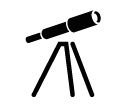
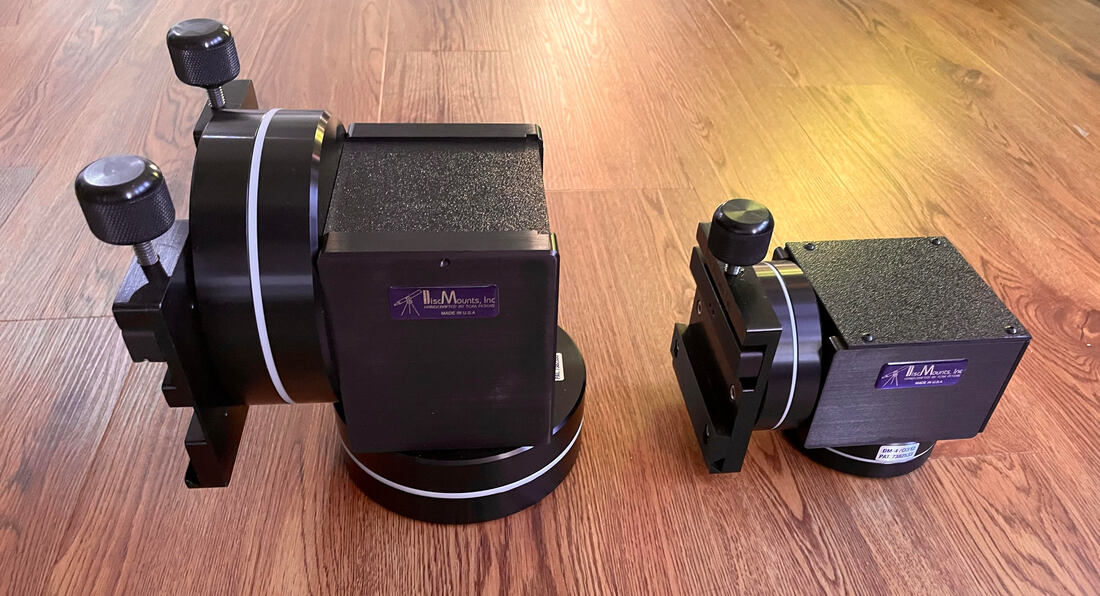
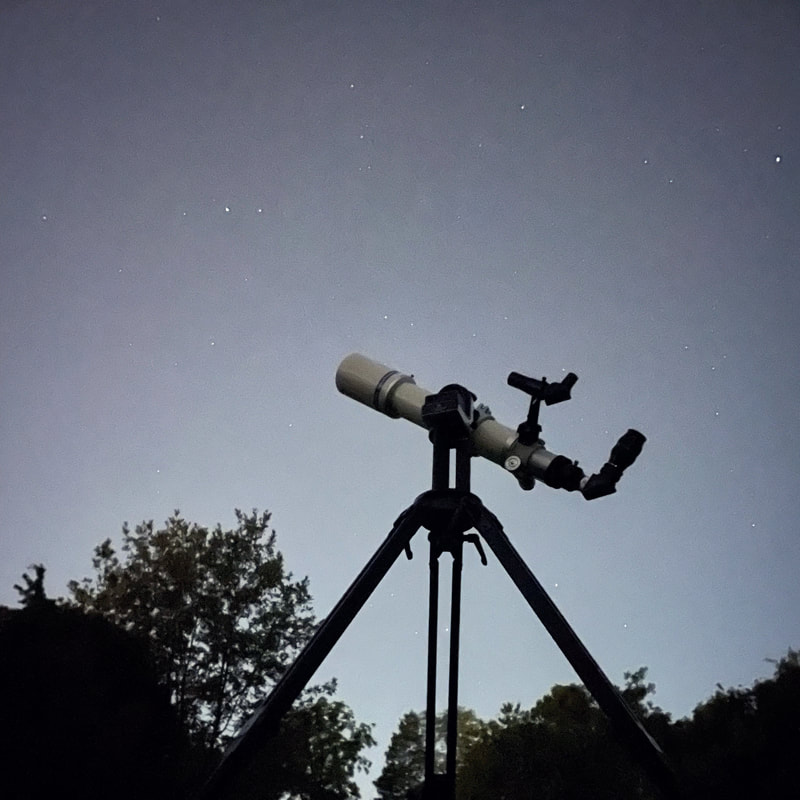
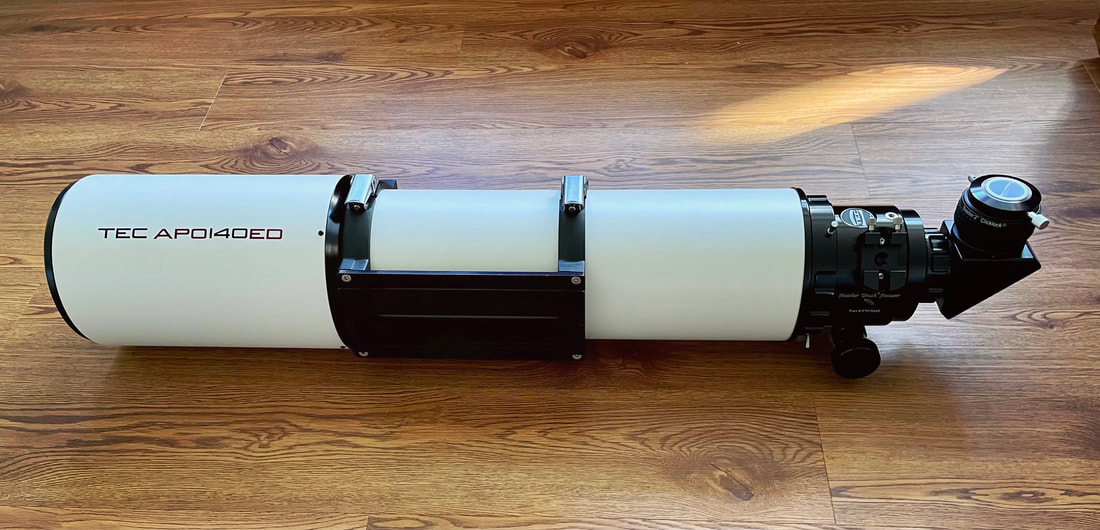
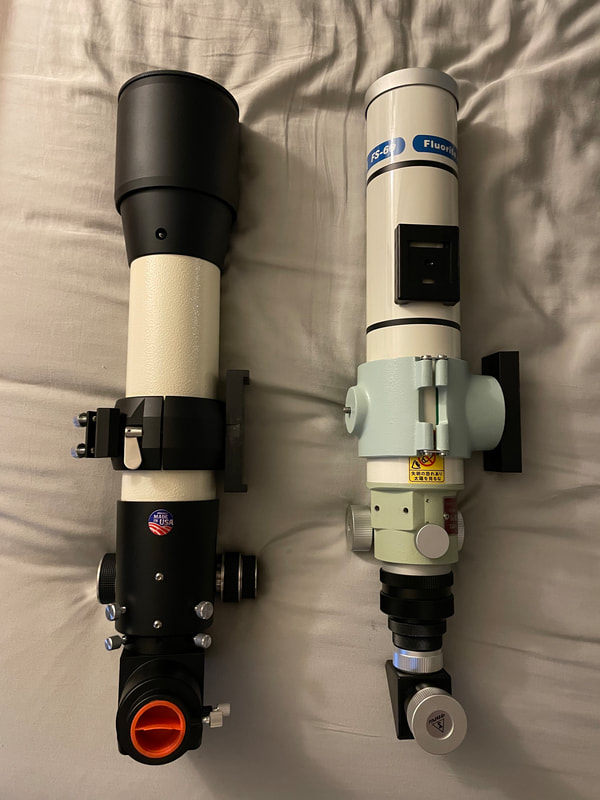
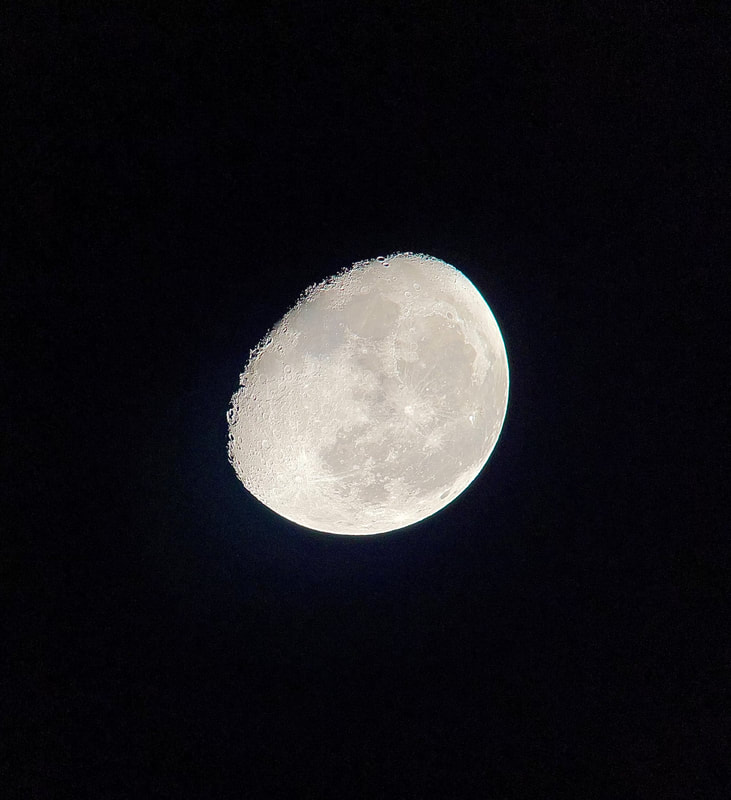
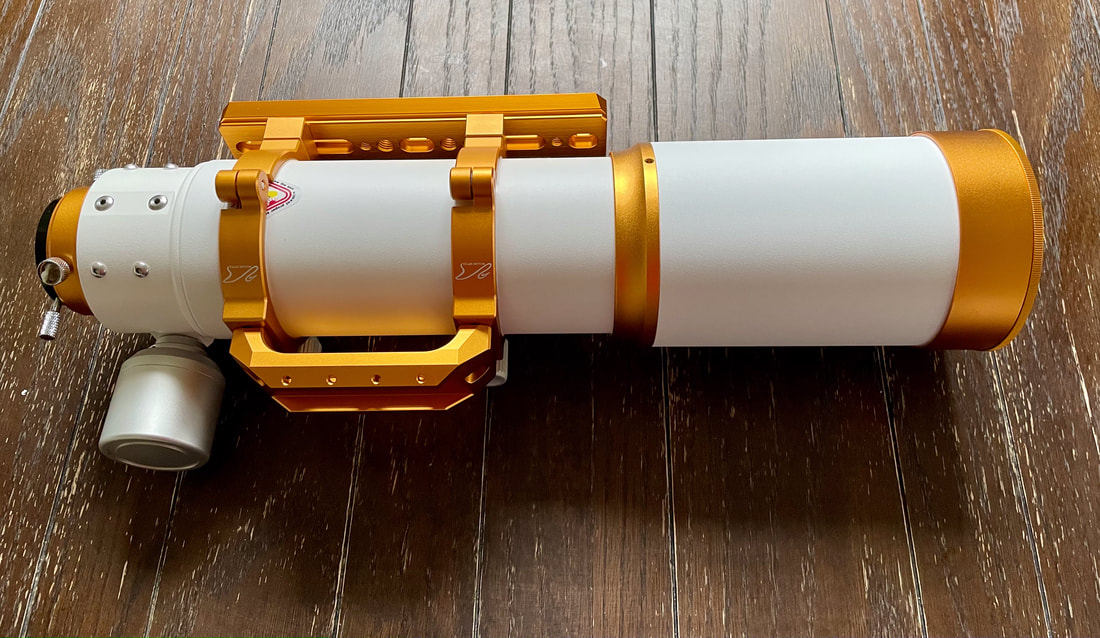
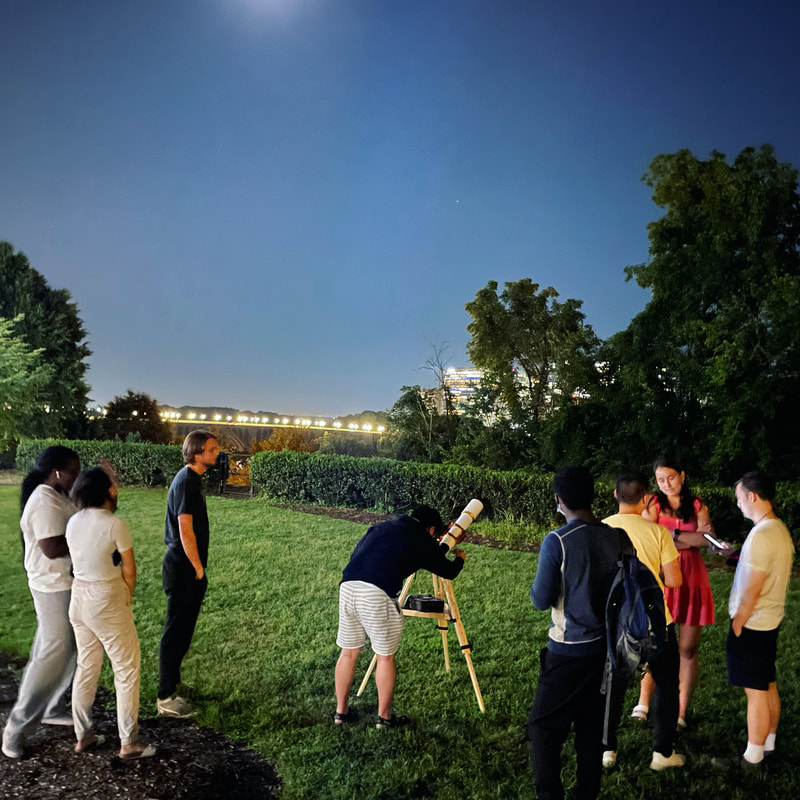
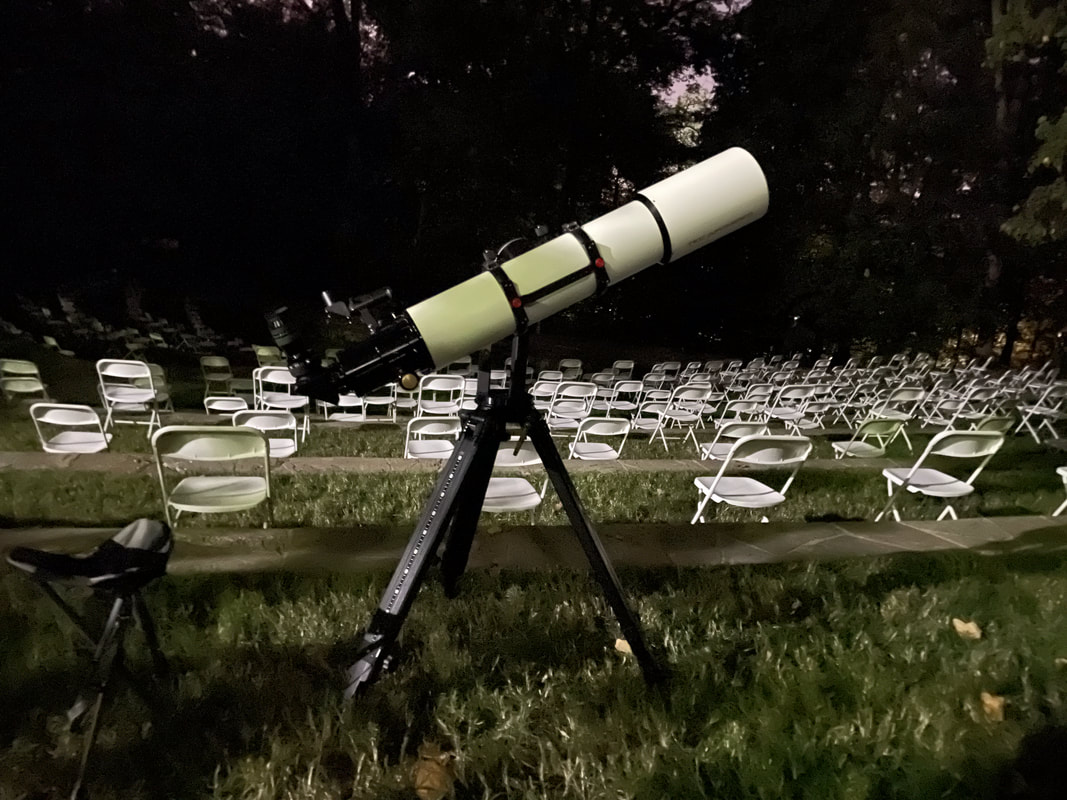
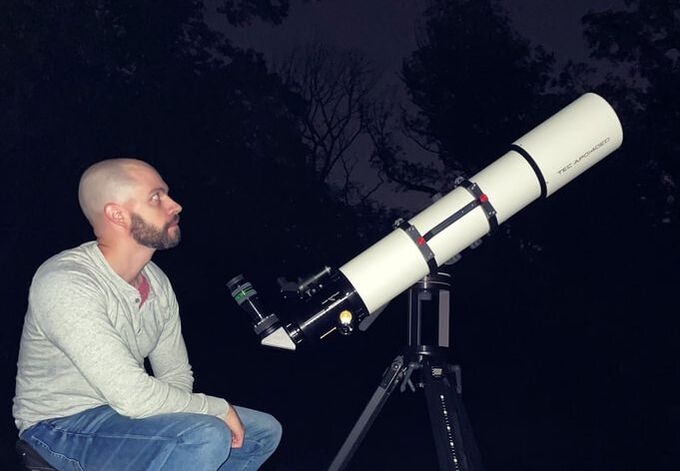
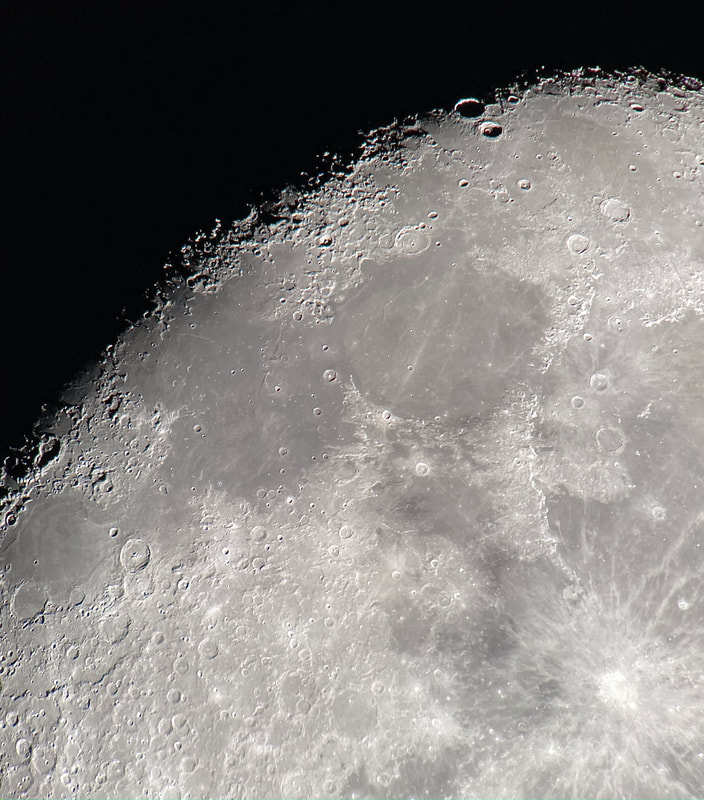
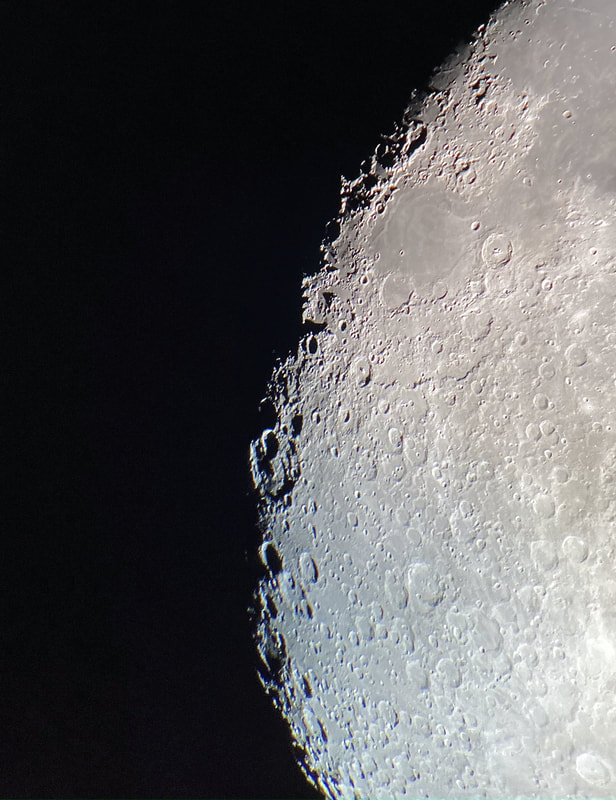
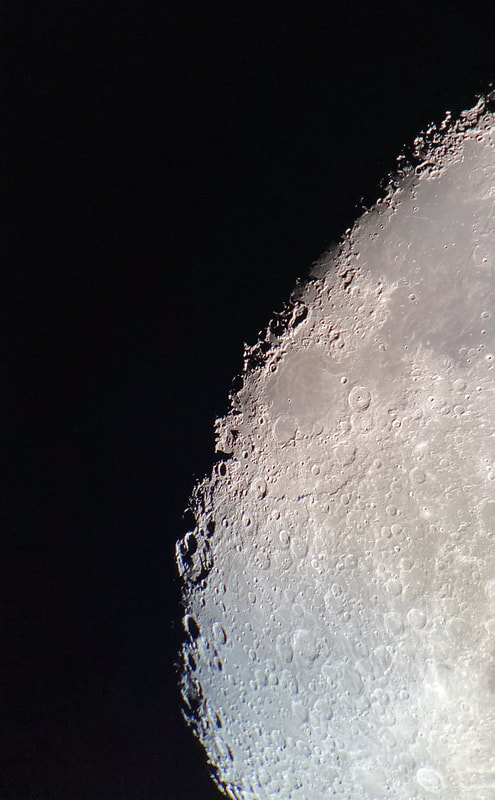
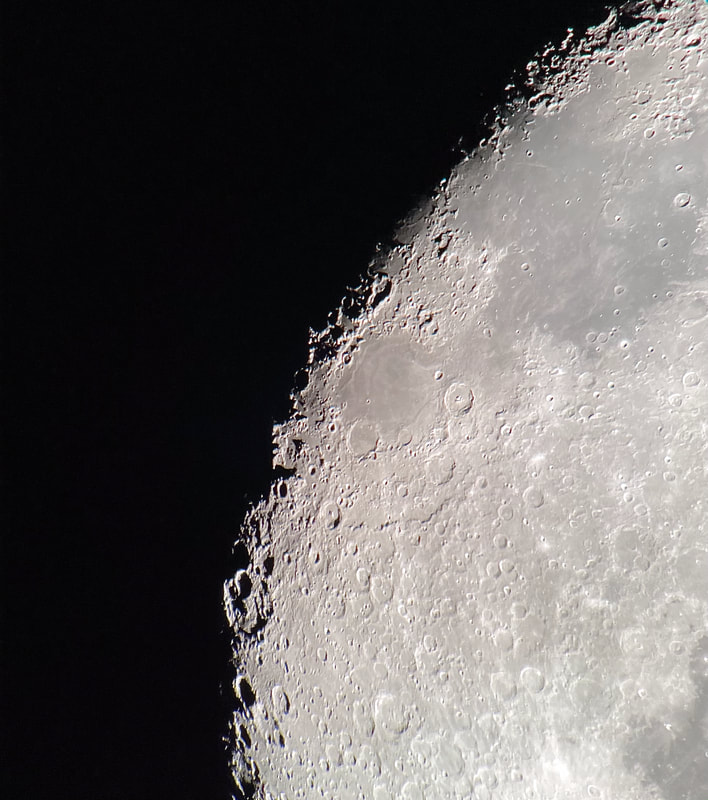
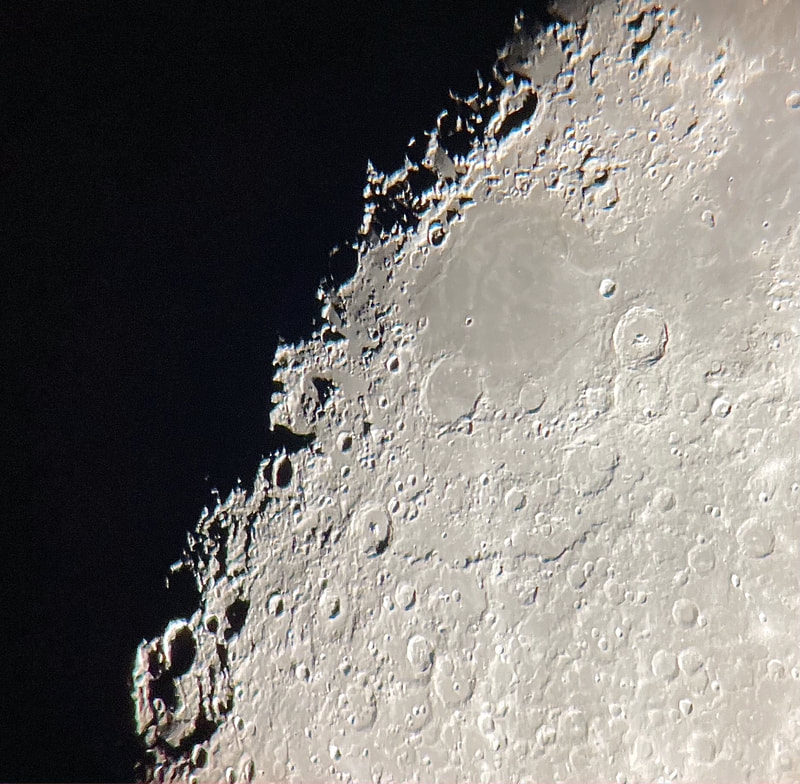
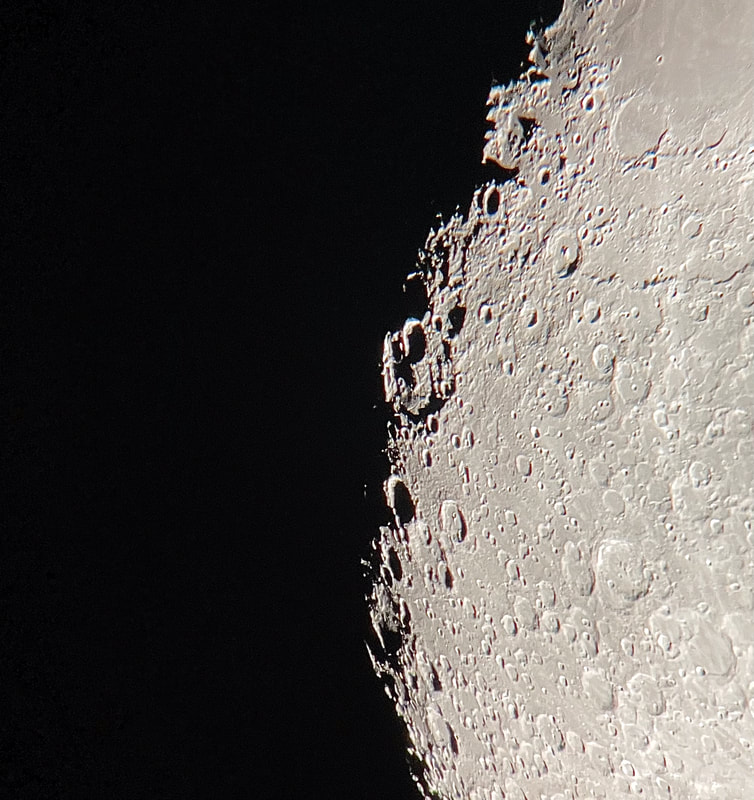
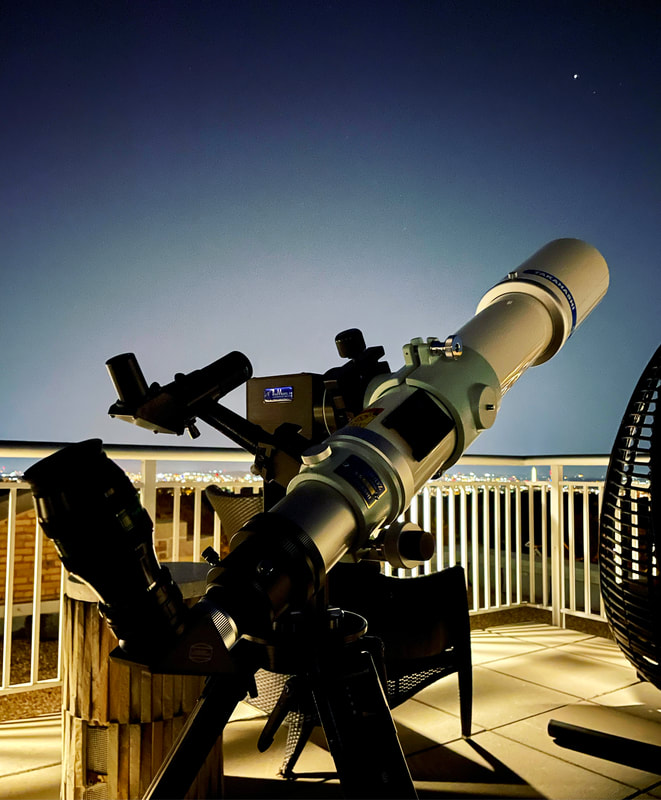
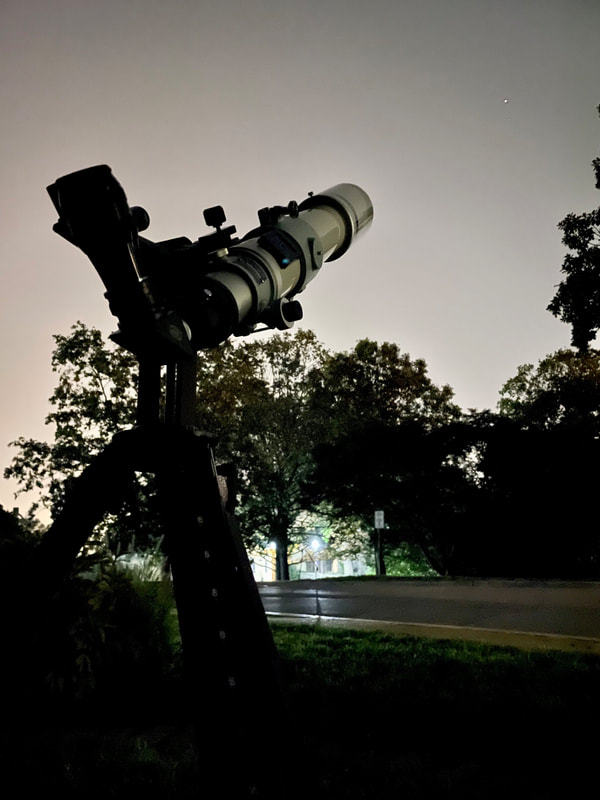
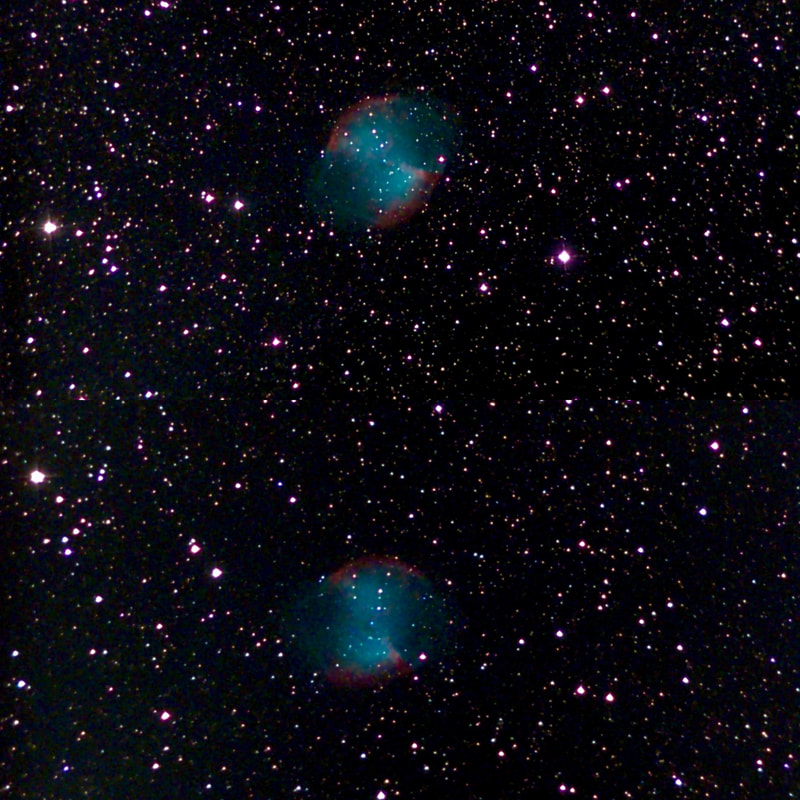

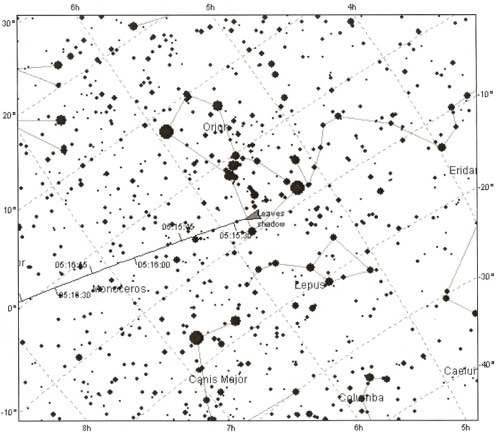
 RSS Feed
RSS Feed